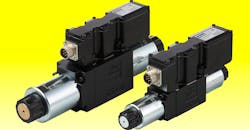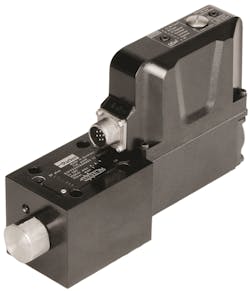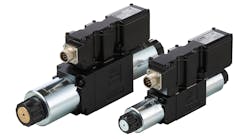Getting the Most out of Electrohydraulic Valves
The basics of electrohydraulic valves are simple: They are electrically operated valves that control how hydraulic fluid is sent to actuators. However, to use them efficiently and effectively, designers must consider several factors. This article will explore seven key design considerations for applying electrohydraulic valves.
On/Off vs. Proportional Valves
On/off valves are basically on/off switches for hydraulic systems. They are typically installed in applications where precise position or speed control is not required. Proportional valves adjust flow rates for hydraulic systems. These valves are typically used in applications where more control and adjustments are needed beyond a standard directional control valve.
A few applications that call for variable flow rate control where proportional valves perform well include wind turbine pitch control, wood processing, machine tools, and metal forming. If specific timing or positioning is required, proportional is the way to go.
The Series D3FP direct-operated control valve from Parker Hannifin combines high dynamics with high flow. It is used for precise accuracy in positioning hydraulic axis and controlling pressure and velocity.
Onboard vs. Offboard Electronics
Determining whether a valve with onboard or offboard electronics is the best choice requires an in-depth evaluation of the application. Generally, onboard electronics put control at the valve, thus simplifying the wiring at the controller. Offboard electronics are often used in areas with high vibration levels and temperatures that can degrade the electronics’ performance.
Driving an offboard electronics valve requires an electronic module, such as a series PWD00A-400, which can be configured to customer-specified parameters such as desired solenoid drive current or ramp rates. Onboard electronics valves can be commanded directly with a standard command including 4-20 mA or ±10 VDC and allow for the same level of customization.
Open vs. Closed-Loop Control
There are two control options for hydraulic systems: open-loop and closed-loop. In general terms, an open-loop system cannot compensate for any disturbances that alter the controller’s driving signal.
Closed-loop systems do not have this shortcoming. Disturbances in the closed-loop setups are compensated for by measuring the output response and comparing it to the input (feedback). If there is an observed difference (known as an error signal), the error is fed back to the controller to adjust the output to the desired value. FB series valves, used for acceleration and metering applications, do not internally close the loop around the spool. FC and FP series valves do close the loop internally around the spool but can be used in either open-loop or closed-loop systems. Error in the system is measured by a transducer, such as a position or speed sensor on an actuator, a pressure transducer, or a flow meter for even greater accuracy. Electrohydraulic servo valves operating in closed-loop control systems use low power and mechanical feedback to provide precise control.
Parameters that must be considered when specifying open- and closed-loop control systems include:
- Hysteresis: The difference in measured output between increasing and decreasing commands.
- Step response: The time required from initial command to when the valve stabilizes at the desired output.
- Frequency response: The maximum speed a valve can operate at accuracy.
- Internal leakage: Bypass flow inherent to spool valves due to mechanical clearances.
- Flow capacity: The amount of fluid that can pass through the valve.
Closed loop control continually considers the current output and alters it to meet the programmed condition. Servovalves use low power and mechanical feedback to provide precise control.
Sizing Spools
Proportional valve spools are typically rated for a nominal flow at a differential pressure of 10 bar and servo valve spools are typically rated for a nominal flow at a differential pressure of 70 bar.
Equal metering spools provide symmetrical flow to each work port. This can be useful when driving a motor or a double-rod cylinder with equal effective areas. Equal metering spools results in reduced speed during retracting of a single-rod cylinder due to the differential area between the rod and piston.
Ratio spools provide asymmetrical flow between work ports. The most commonly used have a 2:1 ratio. When used to drive a 2:1 ratio cylinder, for example, equal speed will be reached between extension and retraction of the cylinder due to matching imbalanced areas.
Engineers should size proportional valves as small as possible to control the load. To maintain control, back pressure must be exerted against the load at all times. A general rule of thumb is to select a spool that will use 90 to 95% of the maximum flow rating. Selecting a spool with too much flow capacity can make the system unstable.
Sealing Compounds
When selecting the compound for elastomeric seals in directional control valves, consult the seal manufacturer’s resources for fluid and compound compatibility information. Industrial applications using mineral oil will typically have a nitrile seal, which is also recommended when controlling water-glycol.
Applications involving high temperatures or less-commonly-used fluids may use one of many grades of fluorocarbon seals. When in doubt, consult the factory for assistance in selecting a seal compound.
Regenerative Circuits and Hybrid Functions
Regenerative circuits route fluid evacuated from the rod end of a cylinder back to the piston end instead of to the tank. This speeds up actuator extension. Regenerative circuits can let system designers use smaller pumps to meet design requirements when rapid movement is needed in only one direction. Some regenerative directional control valves combine on/off and proportional control to let designers to include regenerative functions without adding more valves to the circuit.
Hybrid regenerative valves let designers trigger regenerative control through an electrical signal different from the command signal. When using regenerative control, force is sacrificed for speed. The hybrid function (Z flow code) lets designers select between standard hydraulic function to build force and regenerative function to accelerate the load quickly.
Mounting Patterns
Mounting configurations for electrohydraulic valves are guided by NFPA/ISO standards. D03, D05, D07, D08, and D10 series designations indicate compliance with the standards. Pilot-operated valves are more stable across a wide range of flows and let systems operate with greater flow capacity. Often, the hydraulic pilot pressure used to control the main-stage spool provides greater force than that of a solenoid on a directional drive valve, resulting in more predictable performance for users.
There are many resources available to design engineers when specifying components for systems, including reference sheets, calculators, and configuration tools. However, there is no substitute for experience and application knowledge. Take advantage of the “been there” and “seen that” experience of your supplier’s applications engineers. Not only do they understand how components their company offers perform, they have the benefit of having helped others in the same situation correct design mistakes and they have problem-solved for some of the most unique applications.
Mitch Eichler is an applications engineer, and Tom Gimben and Mathew Davis are product sales managers, all at the Parker Hannifin Hydraulic Valve Division. For assistance with the application of electrohydraulic valves, contact your local Parker distributor or click here.



